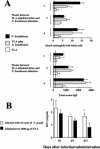Infection with Toxoplasma gondii reduces established and developing Th2 responses induced by Nippostrongylus brasiliensis infection
- PMID: 15213122
- PMCID: PMC427426
- DOI: 10.1128/IAI.72.7.3812-3822.2004
Infection with Toxoplasma gondii reduces established and developing Th2 responses induced by Nippostrongylus brasiliensis infection
Abstract
Oral infection of C57BL/6 mice with 100 cysts of the protozoan parasite Toxoplasma gondii results in the development of small intestinal Th1-type immunopathology. In contrast, infection with intestinal helminths results in the development of protective Th2-type responses. We investigated whether infection with the helminth Nippostrongylus brasiliensis influences the development of T. gondii-induced Th1 responses and immunopathology in C57BL/6 mice infected with T. gondii. Prior as well as simultaneous infection of mice with N. brasiliensis did not alter the course of infection with 100 cysts of T. gondii. Coinfected mice produced high levels of interleukin-12 (IL-12) and gamma interferon (IFN-gamma), developed small intestinal immunopathology, and died at the same time as mice infected with T. gondii. Interestingly, local and systemic N. brasiliensis-induced Th2 responses, including IL-4 and IL-5 production by mesenteric lymph node and spleen cells and numbers of intestinal goblet cells and blood eosinophils, were markedly lower in coinfected than in N. brasiliensis-infected mice. Similar effects were seen when infection with 10 T. gondii cysts was administered following infection with N. brasiliensis. Infection of C57BL/6 mice with 10 T. gondii cysts prior to coinfection with N. brasiliensis inhibited the development of helminth-induced Th2 responses and was associated with higher and prolonged N. brasiliensis egg production. In contrast, oral administration of Toxoplasma lysate prior to N. brasiliensis infection had only a minor and short-lived effect on Th2 responses. Thus, N. brasiliensis-induced Th2 responses fail to alter T. gondii-induced Th1 responses and immunopathology, most likely because Th1 responses develop unchanged in C57BL/6 mice with a prior or simultaneous infection with N. brasiliensis. Our findings contribute to the understanding of immune regulation in coinfected animals and may assist in the design of immunotherapies for human Th1 and Th2 disorders.
Figures






Similar articles
-
Immune responses to Nippostrongylus brasiliensis and tuberculin protein in GATA-3-transgenic mice.Immunol Lett. 2005 Jul 15;99(2):228-35. doi: 10.1016/j.imlet.2005.03.005. Epub 2005 Apr 7. Immunol Lett. 2005. PMID: 16009272
-
Nippostrongylus brasiliensis: cytokine responses and nematode expulsion in normal and IL-4-deficient mice.Exp Parasitol. 1996 Oct;84(1):65-73. doi: 10.1006/expr.1996.0090. Exp Parasitol. 1996. PMID: 8888733
-
Responses of inbred mouse strains to infection with intestinal nematodes.J Helminthol. 2003 Jun;77(2):119-24. doi: 10.1079/JOH2003175. J Helminthol. 2003. PMID: 12756065
-
Turning it on and off: regulation of dendritic cell function in Toxoplasma gondii infection.Immunol Rev. 2004 Oct;201:26-34. doi: 10.1111/j.0105-2896.2004.00179.x. Immunol Rev. 2004. PMID: 15361230 Review.
-
Oral infection of C57BL/6 mice with Toxoplasma gondii: a new model of inflammatory bowel disease?J Infect Dis. 2002 Feb 15;185 Suppl 1:S96-101. doi: 10.1086/338006. J Infect Dis. 2002. PMID: 11865446 Review.
Cited by
-
Concurrent infection with an intestinal helminth parasite impairs host resistance to enteric Citrobacter rodentium and enhances Citrobacter-induced colitis in mice.Infect Immun. 2005 Sep;73(9):5468-81. doi: 10.1128/IAI.73.9.5468-5481.2005. Infect Immun. 2005. PMID: 16113263 Free PMC article.
-
Ascaris suum infection in juvenile pigs elicits a local Th2 response in a setting of ongoing Th1 expansion.Front Immunol. 2024 May 10;15:1396446. doi: 10.3389/fimmu.2024.1396446. eCollection 2024. Front Immunol. 2024. PMID: 38799456 Free PMC article.
-
Amelioration of influenza-induced pathology in mice by coinfection with Trichinella spiralis.Infect Immun. 2006 Mar;74(3):1924-32. doi: 10.1128/IAI.74.3.1924-1932.2006. Infect Immun. 2006. PMID: 16495568 Free PMC article.
-
Neuronal impairment following chronic Toxoplasma gondii infection is aggravated by intestinal nematode challenge in an IFN-γ-dependent manner.J Neuroinflammation. 2019 Jul 29;16(1):159. doi: 10.1186/s12974-019-1539-8. J Neuroinflammation. 2019. PMID: 31352901 Free PMC article.
-
Immune evasion, immunopathology and the regulation of the immune system.Pathogens. 2013 Feb 13;2(1):71-91. doi: 10.3390/pathogens2010071. Pathogens. 2013. PMID: 25436882 Free PMC article. Review.
References
-
- Agnew, D. G., A. A. Lima, R. D. Newman, T. Wuhib, R. D. Moore, R. L. Guerrant, and C. L. Sears. 1998. Cryptosporidiosis in northeastern Brazilian children: association with increased diarrhea morbidity. J. Infect. Dis. 177:754-760. - PubMed
-
- Bashir, M. E., P. Andersen, I. J. Fuss, H. N. Shi, and C. Nagler-Anderson. 2002. An enteric helminth infection protects against an allergic response to dietary antigen. J. Immunol. 169:3284-3292. - PubMed
-
- Bentwich, Z., A. Kalinkovich, Z. Weisman, G. Borkow, N. Beyers, and A. D. Beyers. 1999. Can eradication of helminthic infections change the face of AIDS and tuberculosis? Immunol. Today. 20:485-487. - PubMed
Publication types
MeSH terms
Substances
LinkOut - more resources
Full Text Sources
Medical

